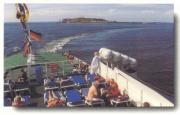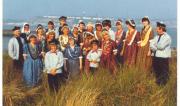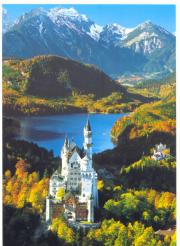I love very much little known small islands where the local people know each other and greet you smiling when passing by. After Lundy in England and Lampedusa between Sicily and Tunisia, I have to add Helgoland in my list of European precious tiny islands.
|
 |
 |
 |
 |
 |
 |
 |
 |
Willkommen an bord. My boat to Helgoland
 |
 |
I was supposed to be these days navigating from Reunion to the French Antarctic Islands of Crozet, Kerguelen, Saint Paul, etc., during 30 days. But my scientific ship MARION DUFRESNE was again delayed. Then, in order to “kill” time, I decided to travel to some German jewels sites that I could not visit in past trips to this country. I started with Helgoland, an island that attracted my interest a few years ago when I was in Zanzibar and learnt that the Germans exchanged some African territories that they possessed, including Zanzibar Island, that is, many thousands of square kilometres, for an islet of the Frisian archipelago, at about 70 kilometres north of Germany, in the North Sea (Nordsee), with a surface of 160 hectares! I arrived to Cuxhaven, took a ship called “Wappen von Hamburg” and after two hours I arrived to Helgoland waters. Then a small motor boat transferred us in turns to the harbour. All the tourists were excited and the first thing that they did upon disembarking was to buy in the shops around the port lots of products at tax free prices because Helgoland, as well as Busingen, a German enclave located within Switzerland, is a Tax Exemption Territory. I noticed that I was the only foreigner in the ship, and once in the island everybody spoke exclusively German and all the tourist brochures were only written in this language. When I addressed in English to the locals, they understood me but their reply was invariably in German, what I appreciated because a traveller has to try to speak the language of the country that he visits if he wants to understand it. For me that was “kein problem” since I had studied German in the past and except the first hour that I felt lazy and used mainly English, the rest of my stay in Germany I would manage in German language only, natürlich! After all German is the second most spoken language in Europe, with over 100 millions speakers, which make it the sixth most spoken language in the world.
|
|
| Favourite spots: |
 |
 |
 |
 |
 |
 |
 |
 |
Old picture of the Big Bang over Helgoland in 1947
 |
 |
HISTORY OF HELGOLAND. Thanks to the pyramidal advertisings along the path in the UBERLAND, I learnt that the island belonged from 1402 to 1714 to Holstein, then to Denmark until 1807, when the English took it. In 1890, during the “Scramble for Africa” period, Germany (well, then was Prussia) offered Zanzibar and other territories in today’s Tanzania for Helgoland, and the English agreed. Being such a strategically point in the mouth of the River Elba, the Germans fortified the island, including bunkers with heavy artillery and shelters for submarines. In 1919, the fortifications were dismantled. Some years later the German Government reconstructed the island and was converted in one of the main bases for submarines. After the German defeat in the WWII, the English occupied the island and destroyed part of it with the massive launching in their RAF airplanes of more than 6700 tons of bombs, what is known as the BIG BANG. But Helgoland survived again like the Phoenix from the ashes.
|
|
| What's really great: |
 |
 |
 |
 |
 |
 |
 |
 |
Aerial view of Helgoland and Dune islands
 |
 |
UBERLAND is the high part of the island, where live the majority of the local people. You can get up there by lift (55 cents of euro), or walking up the steps. The perimeter of UBERLAND is marked on the floor every 500 metres, and it takes you about one and a half hours to walk it through. The views are magnificent! There are multitudes of seagulls and other birds over flying the island and taking refugee in the holes formed by the cliffs (about 15.000 birds stop annually in Helgoland, where there is a Bird Protection Station). There are also some cows and the Lighthouse. The symbol of Helgoland is LANGE ANNA, or a rock tower with a characteristic form. From the Uberland you can see DUNE, an adjacent islet where is located the airport of Helgoland. In Uberland I visited the St. Nicolai Church, erected in 1685 but destroyed in 1945 by the allies. Today, a part of it is devoted as a memorial to the Germans fallen during the First and the Second World Wars.
|
|
| Sights: |
 |
 |
 |
 |
 |
 |
 |
 |
My ticket to the Gemaldegalerie. Painting by Antonello de Messina
 |
 |
After visiting Helgoland I continued my journey around Germany. The next stop was Dresde. I had one main reason to visit this pretty town, the capital of Saxony: the Zwinger Palace and its Gemaldegalerie Museum, one of the best in the world, containing over 2000 chef d’oeuvres of the most important Europeans artists, from Jan van Eyck to Albrecht Durer, from Botticelli to Murillo. The main treasure is the famous Madonna Sixtina, painted by Rafael in 1514. There are many wonderful Rembrandts (in Madrid El Prado, unfortunately, we have only one). The Spanish collection includes El Greco, Murillo, Jose de Ribera, Velazquez and Goya. There are several Rubens, many Tizian and Canaletto, but I only found one Bassano.
Germans hid the treasures of this museum during the WWII, but in 1945 the Soviets took most of the paintings to Moscow, and only ten years later the Germans could recuperate them.
The ruins of Frauenkirche, in Dresde, remind the traveller the horrors of the war.
|
|
| Accommodations: |
 |
 |
 |
 |
 |
 |
 |
 |
Helgoland and its landmark LANGE ANNA
 |
 |
MITTELLAND. Helgoland is considered the healthiest place in Germany because is very poor in pollens, what help the asthmatics and allergic people, who go to the private clinic situated in Mittelland as to a health resort. Just by breathing they get better. Helgoland is pure nature. There is less dust particles in Helgoland than in the Zugspitze, the highest German peak, in the Bavarian Alps (2962 metres). Because of the Gulf Stream the island enjoys a very pleasant weather with more sunny days than the rest of Germany.
There are no cars in the island except the ambulance of the clinic and some small trucks for distributing the goods to the shops, hotels and restaurants. Everybody must walk.
|
|
| Nightlife: |
 |
 |
 |
 |
 |
 |
 |
 |
German folks posing in front of Helgoland Island
 |
 |
In UNTERLAND there is the port, shops, hotels and restaurants. When you arrive to the island you will be offered a ride in the touristy electric train called Inselbahn.
Besides the harbour for the catamaran, there is a sign indicating the distances in kilometres from Helgoland to the following places: Zanzibar 7335, Tasmania 17166, Robinson Crusoe 12900, Pitcairn 16060, etc.
Sometimes you may see sea lions (“seehunde”) lying in the beach, but I did not see any during the two days that I spent in the Island.
Just in the harbour there is a bust devoted to August Heinrich Hoffmann von Fallersleben, who several times spent his holidays in Helgoland, where he wrote in 1841 “Deutschlandlied”, whose third strophe became in 1922 the text of the song of the Germans, their national anthem.
Some other remarkable visitors to Helgoland were the Kaiser Wilhelm II, in 1890, and also the Czech writer Franz Kafka and the German poet Heinrich Heine. Goethe wrote a poem about Helgoland.
|
|
| Hangouts: |
 |
 |
 |
 |
 |
 |
 |
 |
German tourists walking in Helgoland Unterland streets
 |
 |
Today, Helgoland has a population of about 1600 inhabitants. There is a very nice museum (cost only 2 euro), football, tennis and golf grounds, swimming pools, cinemas, public library, concerts, a cultural centre, and almost all the advantages of the civilization, but not the inconveniences. They even have an own flag formed by the colours green on the top, red in the middle and white on the bottom.
|
|
| Restaurants: |
 |
 |
 |
 |
 |
 |
 |
 |
View of the harbour in Helgoland
 |
 |
While in Helgoland you should try the Helgoland lobster (if you can afford it; I could not), the “Kniepers” or the scissors of the crab, the smoked local fish, and specially the herrings (in German are called Sprotten) which are delicious and have to be eaten in the German way: you take off the head and eat the rest except the tail, including bones. Herrings together with one beer Beck’s (or two!) constitute a perfect appetizer.
In the port of Cuxhaven there is a kiosk where they sell sprotten at only 12 euro the kilogram. I used to go there during two days for breakfast, for lunch and for dinner, and finished up making friendship with the owners.
In the rest of Germany you have many varieties of Wursts, or typical German sausages, with mustard or curry sauce. Every Lander has its own Wurst speciality. And since in Germany live so many thousands of Turkish, you can find cheap donner kebaps in any corner. There are also Chinese restaurants offering menus for 6 euro.
|
|
| Other recommendations: |
 |
 |
 |
 |
 |
 |
 |
 |
Ravishing castle Neuschwastein
 |
 |
This castle Neuschwastein, in Bavaria, was the major fantasy of my journey to Germany. The artifice of it was the Bavarian King Ludwig Wilhelm II.
The best way to get there is by bicycle thorough the Romantic Road (Romantische Strasse), from Wurzburg to Fussen. But I had not enough time for that, therefore I arrived by train to Fussen and trekked to the marvellous castle and the lakes surrounding it. You have to climb to the Marienbrucke to admire it better. Externally the castle looks like a fairy tale (it inspired Walt Disney’ Sleeping Beauty), and internally reflects the interest of the King Ludwig Wilhelm II for the legends that convey the operas of Richard Wagner (he was his economical benefactor). For instance, the history of Lohengrin produced the Great Chamber and the Hall of the Throne, in Byzantine style. To evoke Tannhauser it was disposed a winter garden and a grotto with stalactites. The Hall of Music is dedicated to the life of Parsifal, etc.
|
|
Published on Thursday August 4th, 2005
|
|
 Publish on Facebook
Publish on Facebook
|
Fri, Jan 09 2009 - 06:53 AM
 by hieronyma
Jorge! The title is irritating but the report especially about Helgoland makes me sure that I want to go there as I planned to do a while ago. I love islands and this is a special one. Thank you, now I know what to do there and what to look at.
Christl |
Thu, Aug 17 2006 - 12:48 PM
 by trondpg by trondpg
A very good and comprehencive report, however you bring forward a coomon misunderstanding about the Helgoland - Zanzibar treaty. In fact Zanzibar have never been German, until 1890 it was a Omani sultanate. See http://en.wikipedia.org/wiki/Helgoland-Zanzibar_Treaty
Trond |
Sun, Jan 08 2006 - 05:19 PM
 by bertison by bertison
well done, but why the hell is neuschwanstein in connection with helgoland?
|
Fri, Aug 05 2005 - 05:24 PM
 by eirekay by eirekay
Jorge, another wonderful report! Love the picture in costume!
Eire |
Fri, Aug 05 2005 - 05:23 AM
 by davidx by davidx
| You really bring to life a place that has just been a location on our shipping weather forecast before! |
| Information: |
| Login if you are a member, or sign up for a free membership to rate this report and to earn globo points! |
|
| Afghanistan |
|
|
 |
| Argentina |
|
|
 |
| Bosnia - Herzegovina |
|
|
 |
| Brazil |
|
|
 |
| Canada |
|
|
|
|
|
|
 |
| Chad |
|
|
 |
| Chile |
|
|
 |
| China |
|
|
 |
| Christmas Island |
|
|
 |
| Colombia |
|
|
 |
| Dominica |
|
|
 |
| Falkland Islands |
|
|
 |
| Germany |
|
|
|

|
